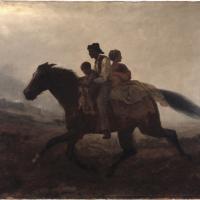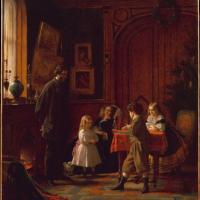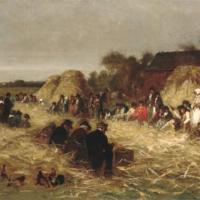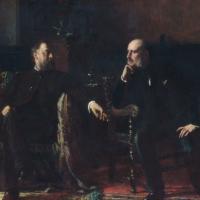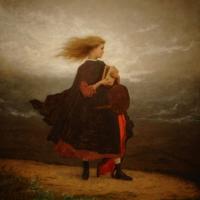Eastman Johnson
A Different Sugaring Off
$450.00
Corn Husking At Nantucket
$450.00
Feeding The Turkey
$450.00
Not At Home
$480.00
The Girl I Left Behind Me
$450.00
The Hatch Family
$480.00
The Lord Is My Shepherd
$450.00
Eastman Johnson
Jonathan Eastman Johnson (July 29, 1824 – April 5, 1906) was an American painter and co-founder of the Metropolitan Museum of Art, New York City, with his name inscribed at its entrance. He was best known for his genre paintings, paintings of scenes from everyday life, and his portraits both of everyday people and prominent Americans such as Abraham Lincoln, Nathaniel Hawthorne, Ralph Waldo Emerson, and Henry Wadsworth Longfellow. His later works often show the influence of the 17th-century Dutch masters, whom he studied in The Hague in the 1850s; he was known as The American Rembrandt in his day.
Eastman Johnson's career as an artist began when his father apprenticed him in 1840 to a Boston lithographer. After his father's political patron, the Governor of Maine John Fairfield, entered the US Senate, the senior Johnson was appointed by US President James Polk in the late 1840s as Chief Clerk in the Bureau of Construction, Equipment, and Repair of the Navy Department. The family moved to Washington, DC and first lived in rental housing. In 1853, they bought a new rowhouse at 266 F Street, between Thirteenth and Fourteenth streets and a few blocks from the White House and the Navy Department offices, which became their permanent home. Although the young Johnson lived for a time in Boston, and studied in Europe, he used this home as his base until moving to New York City in the late 1850s.
The young Johnson moved to Washington, D.C. at about age 20, supporting himself by making crayon portraits, including John Quincy Adams, and Dolly Madison, and likely helped by his father's political connections. He returned to New England, settling in Boston in 1846 at the age of 22.
In 1849, Johnson went overseas to Düsseldorf, Germany, for further studies. This had become a new center where many artists, including many Americans, studied art. They took part in the Düsseldorf school of painting. In January 1851, Johnson was accepted into the studio of Emanuel Gottlieb Leutze, a German who had lived in the United States for a while before returning to Germany. His major work completed there is his portrait of Worthington Whittredge.
Johnson moved to The Hague, where he studied 17th-century Dutch and Flemish masters. He ended his European travels in Paris, studying with the academic painter Thomas Couture in 1855 before returning to the United States that year due to the death of his mother.
In 1856, he visited his sister Sarah and her family in Superior, Wisconsin. His mixed-race guide Stephen Bonga, who was Ojibwe and African-American, took Johnson among the native Anishinaabe (Ojibwe) in the areas around Superior. Throughout 1857 Johnson frequently painted them in intimate, casual poses. According to the Wisconsin Historical Society, Johnson traveled with Bonga to the areas today known as Grand Portage National Monument, Apostle Islands National Monument, and Isle Royale National Park.
By 1859, Johnson had returned to the East and established a studio in New York City. He secured his reputation as an American artist that year with an exhibit at the National Academy of Design featuring his painting, Negro Life at the South (1859) or, as it was popularly called, Old Kentucky Home. It was set in the urban back yards of Washington, DC rather than on a plantation. That year Johnson was elected into the National Academy of Design as an Associate member and became a full Academician in 1860.
Johnson also became a member of the Union League Club of New York, which holds many of his paintings. In 1869, at the age of 55, he married for the first time, to Elizabeth Buckley. They had one daughter, Ethel Eastman Johnson, born in 1870. Ethel married Alfred Ronalds Conkling (nephew of Senator Roscoe Conkling) in 1896.
On his death in 1906, Eastman Johnson was buried at Green-Wood Cemetery in Brooklyn, New York.
Johnson's style is largely realistic in both subject matter and in execution. His charcoal sketches were not strongly influenced by period artists, but are informed more by his lithography training. Later works show influence by the 17th-century Dutch and Flemish masters, and also by Jean-François Millet. Echoes of Millet's The Gleaners can be seen in Johnson's The Cranberry Harvest, Island of Nantucket, although the emotional tone of the work is far different.
His careful portrayal of individuals rather than stereotypes enhances the realism of his paintings. Ojibwe artist Carl Gawboy notes that the faces in the 1857 portraits of Ojibwe people by Johnson are recognizable in people in the Ojibwe community today. Some of his paintings, such as Ojibwe Wigwam at Grand Portage, are highly realistic, with details seen in the later photorealism movement.
His careful attention to light sources contributes to the realism. Portraits, Girl and Pets and The Boy Lincoln, make use of single light sources in a manner that is similar to the 17th-century Dutch Masters whom he had studied in The Hague in the 1850s.



